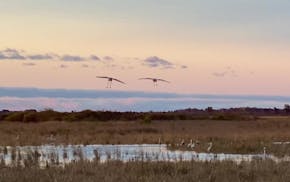Seeds are amazing. Even something as simple as a bean plant sprouting in a Dixie cup is a miracle if you think about it. You take this thing that looks brown and lifeless, add water, warmth and something for the roots to grow in and you're rewarded with a living, growing plant.
Many gardeners are hooked on growing plants from seed -- and not just because it's fun to watch the process. Starting from seed gives you a wider choice of plants than you might find as seedlings at your local nursery.
Noteworthy new seeds While you may have your tried-and-true seeds, it's always fun to pick out a few new things to try. Here are some suggestions for 2008:
• Garden-grown baby carrots are infinitely tastier than the milled carrot chunks sold in bags at grocery stores. This year look for 'Sweet Baby Jane,' a tiny tasty that matures quickly.
• Baby cucumbers are one of the great new mini-veggies perfectly suited for lunch bags or elegant crudité trays. Look for seeds of 'Top Green' or the somewhat unfortunately named 'Green Fingers.'
• If size matters, try 'Wyatt's Wonder' pumpkin, a globe-shaped, deep-orange beauty that will grow to 70 to 150 pounds during the summer. (Cinderella costume not included.)
• Heirloom tomatoes are often touted for flavor, but they tend to produce later and more sparsely than many hybrids. A new indeterminate hybrid tomato cultivar, 'Country Taste,' bears dark red, 1-pound fruits that are reported to taste as good as an heirloom.
• Who can resist timeless petunias with their fragrant, prolific blooms? A winner for this year is 'Opera Supreme Lilac Ice,' a heavy bloomer that can spread more than 10 feet. (One caution: Petunias have tiny seeds that require a long head start, so if you want to grow them yourself, start them by early March.)
• China Town plume celosia combines dramatic red flowers and stems with deep-green to bronze-purple foliage. It's great for annual beds and container plantings.
• Annual vinca (also known as Madagascar periwinkle) is a fabulous annual for hot, dry sites. Unfortunately, many annual vincas have been susceptible to a disease that makes them rot at the soil line in wet or humid conditions. The new Cora hybrids in a range of bright colors are very disease-resistant.
Directly into the garden If you don't have the space, time or energy to start seeds indoors, don't throw in the trowel. There are plenty of flower and vegetable seeds that can be sown directly outdoors. In fact, that's the best way to grow some plants.
For example, root vegetables such as radishes, carrots and parsnips should be started directly in well-worked garden soil. Leafy greens (arugula, spinach, leaf lettuce) and quick-growing flowers (cosmos, sunflowers, zinnias) also do perfectly well with direct seeding.
And then there are plants that are just plain crabby about being transplanted, including sweet peas, pumpkins and poppies. These plants often suffer a big slowdown in growth when transplanted from containers to garden, so it's best to plant the seeds directly in the garden.
Seed-starting basics Given our short growing season, many flower and vegetable seeds need to be started indoors in March or early April. An initial investment in quality soilless potting mix, lighting (fluorescent shop lights work well) and maybe a heating mat will make indoor seed starting easy.
Nancy Rose is a horticulturist with the University of Minnesota Extension. To ask her a gardening question, call 612-673-9073 and leave a message. She will answer questions in this column only.
Sign up for Star Tribune newsletters

Sandhill cranes coming to roost
Oscar-winning actor Maggie Smith dies at 89
